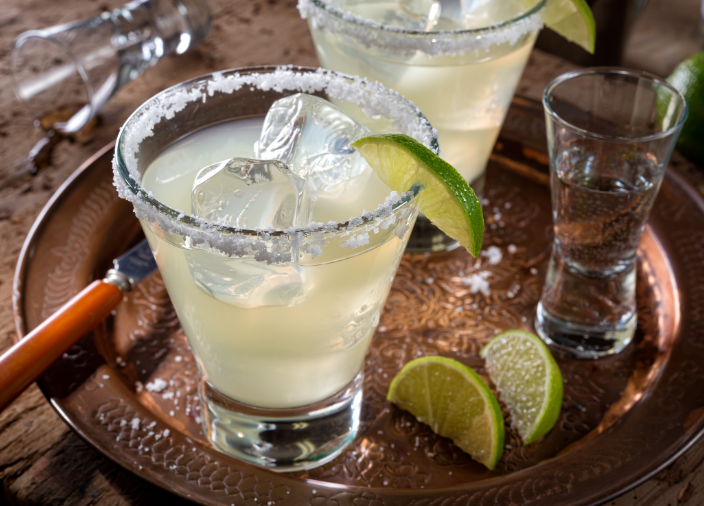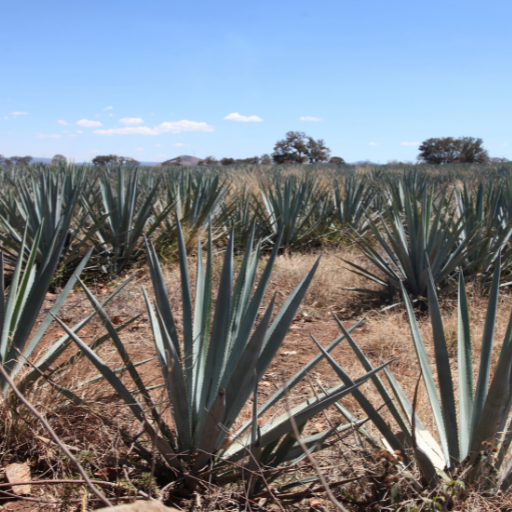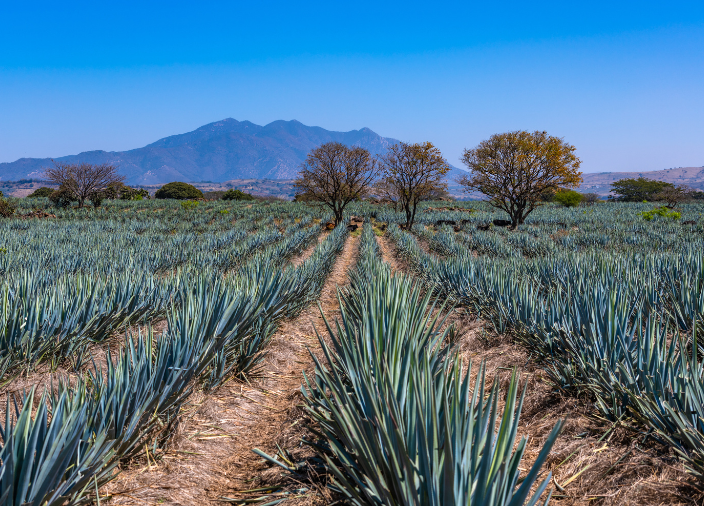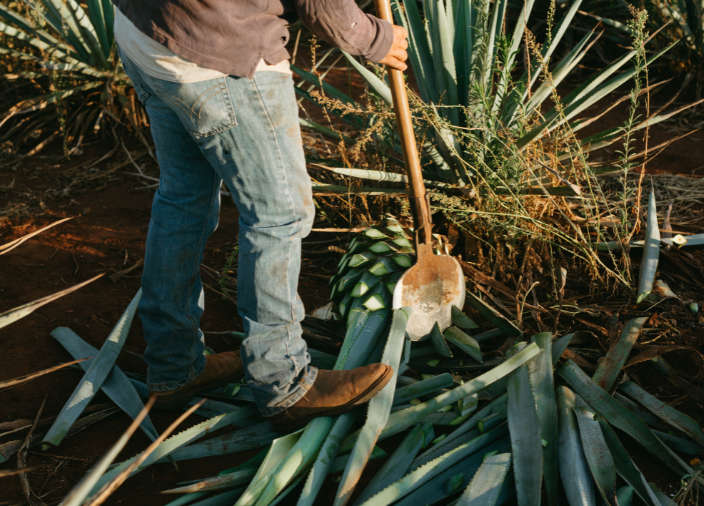
Tequila: History and Production
Step into the world of tequila and learn more about its storied history, production process, premium expressions, and innovative cocktails.
Estimated Reading Time: 5 Minutes
Explore the world of tequila: its history, production process, cultural significance, and versatile appeal. Learn about the revered blue agave, premium expressions, and innovative cocktails.
What is Tequila?
Tequila is a distilled spirit made from (and only from) the Blue Weber Agave. It’s the plant’s heart; the piña, that holds the power.
The History of Tequila

The History of Tequila
Centuries ago, legend has it that a bolt of lightning struck an agave plant in an agave field, setting it ablaze. The heat caused a natural fermentation process, resulting in a sweet liquid known as "pulque." Pulque quickly gained sacred status among indigenous people and was used in spiritual rituals due to its unique origins, extraordinary taste, and mystical aura.
The arrival of the conquistadors in 1519 introduced the country to new distillation techniques and copper stills (the first on the continent). The Spanish explorers discovered they could distill agave to produce a more potent spirit beginning the transition from pulque to a drink they referred to as "Mezcal Wine from Tequila." As the distillate gained in popularity, the name "Tequila" emerged, a testament to its origin region.
Tequila Regulation and Recognition

Tequila Regulation and Recognition
In 1944, the Mexican government established regulations for tequila production to ensure quality and authenticity. Innovators like Don Julio González played a crucial role in defining industry standards and protecting the spirit's name from foreign imitators.
The Man, The Legend: Don Julio Share How He Started Making Tequila
The Agave
The agave plant is endemic to Mesoamerica and has grown in Mexican soil for more than 10,000 years.
More than 200 species exist, but since 1964, tequila can only be made with the Agave Tequilana Weber Azul.
The blue Weber has a distinctly sweet flavor in comparison to other species of agave and grows into large succulents with spick fleshy leaves that can reach over two meters in height, distinguished by their green-blue hue.
Agave plants reach maturation at around five years old.
The Eight Steps of Tequila Production

The Eight Steps of Tequila Production
Producing tequila is a truly distinctive blend of art and science, with craftsmanship and knowledge equally significant to the process. Tequila is a protected name, and it is made exclusively in five Mexican states: Jalisco, Nayarit, Guanajuato, Michoacan, and Tamaulipas.
Harvesting: The process starts with harvesting blue agave plants, which take around 6-10 years to mature. The piña, or heart of the agave plant, is the part used for tequila production.
Cooking: Jimadors remove the leaves and cook the harvested piñas to convert the starches into fermentable sugars. Traditionally, they are baked in stone ovens called "hornos." In modern distilleries, they may be cooked in autoclaves (drum-like pressure cookers).
Shredding and Extracting Juice: After 24 to 48 hours in the oven, the softened piñas are shredded to extract their sweet juice (Aguamiel) using mechanical shredders or crushed using traditional methods like the Tahona wheel, a large stone wheel pulled by a mule.
Fermentation: The extracted juice, or "aguamiel," is transferred to fermentation tanks, and yeast is added to convert the sugars into a low-alcohol liquid called "mosto." Distillers can use up to 49% of other fermentable sugars (usually molasses or corn-base syrup) as part of their 'Mosto (wort) formulation. If blue Weber agave is the only source of sugar used, the tequila produced is labeled 'Tequila 100% Agave'.
Distillation: Using a combination of column and pot stills (or, traditionally, only pot stills), after the first distillation, a flavorful clear spirit called Ordinario is collected at 20 to 25% ABV. However, tequila must be distilled at least twice, and the second distillation will refine the spirits further at around 55 to 75% ABV.
Further Distillation (optional): Producers of higher-quality tequilas will aim for lower strengths to retain agave flavors and characteristics. Triple distillation in tequila is rare but does exist.
Maturation (Reposado/Añejo/Extra Añejo): Tequilas are categorized on how long they have been aged (or not). The type of cask used may be new or previously aged with tequila or other spirits. The size of the cask will vary based on how much oak influence is preferred and the type of tequila. The most common will be the ex-Bourbon cask.
Bottling: According to Mexican regulation, tequila can be bottled between 35 to 55% ABV. This is slightly different for the export market (U.S. 40% min ABV, Europe 37.5% min ABV). Additives such as caramel coloring, sugar, and oak extracts may be used in limited quantities for all categories except Blanco Tequila. Tequila 100% Agave must be bottled within the five Tequila regions.
Types of Tequila:
The following categories will apply to both tequilas made from a minimum of 51% blue Weber agave and 100% agave:
Blanco/Silver/Plata Tequila: A clear (but not necessarily colorless) spirit aged for up to 60 days with vegetal, earthy agave notes.
Joven/Gold Tequila: Joven (young) or oro (gold) tequila is generally basic tequila with additives such as coloring and flavorings. Exceptions include blending silver tequila with reposado, añejo, and muy añejo tequilas whilst retaining the 100% de Agave classification.
Reposado Tequila: Reposado (rested) tequila must be matured in American oak or Encino oak cask for at least 60 days. The casks used impart oak and caramel flavors and give a distinctive golden hue, as well as softening the agave characteristics.
Añejo Tequila: Tequila like Don Julio Añejo (content ID 1078) is aged for a minimum of 1 year, often in bourbon or French oak casks, resulting in a darker, hearty spirit that entertains a balance of agave and wood flavors.
Muy Añejo tequila – Muy Añejo (Ultra Aged) tequila must be aged for a minimum of 3 years in a cask with a maximum capacity of 600 liters. This softens the spirit with notes of caramel, vanilla, and oak and makes it ideal for sipping.
Other Agave Spirits

Other Agave Spirits
Mezcal: Noted for its characteristically smoky flavors, mezcal can be produced from eight different varieties of the agave plant, like Espadin or Tobala. Most of the smoky notes derive from the production process, where the piña is roasted in stone-lined pits, crushed, and added with water to a barrel to ferment.
Raicilla: Made from a range of agave that are roasted and typically single-pot distilled. Raicilla is almost exclusively produced in Puerta Vallarta and the Occidental Mountains.
Sotol: Made from a succulent called dasylirion instead of agave. Sotol is a regional spirit from Chihuahua and observes many regulations like tequila.
Bacanora: An agave spirit made in the state of Sonora using only the Agave Angusifolia Espadin.
Tequila Recipes
On the rocks or a Negroni with a twist, explore Tequila cocktails and more in our recipes section.
For tips, trends, recipes and more, sign up the Diageo Bar Academy newsletter.
